A student internship
It’s safe to say, each of us were equally as excited to be part of an all-female team representing women in science. Our international research team consisted of myself (Grace), a visiting master’s student from the University of York, UK, conducting a two-month internship with SARA, Annmarie, a master’s student from the University of Mississippi, USA, visiting Australia as part of the ‘Saw Search’ project, Julia, an Aussie native and undergraduate student at the University of Wollongong, and of course Dr. Barbara Wueringer, principal scientist and founder of SARA.
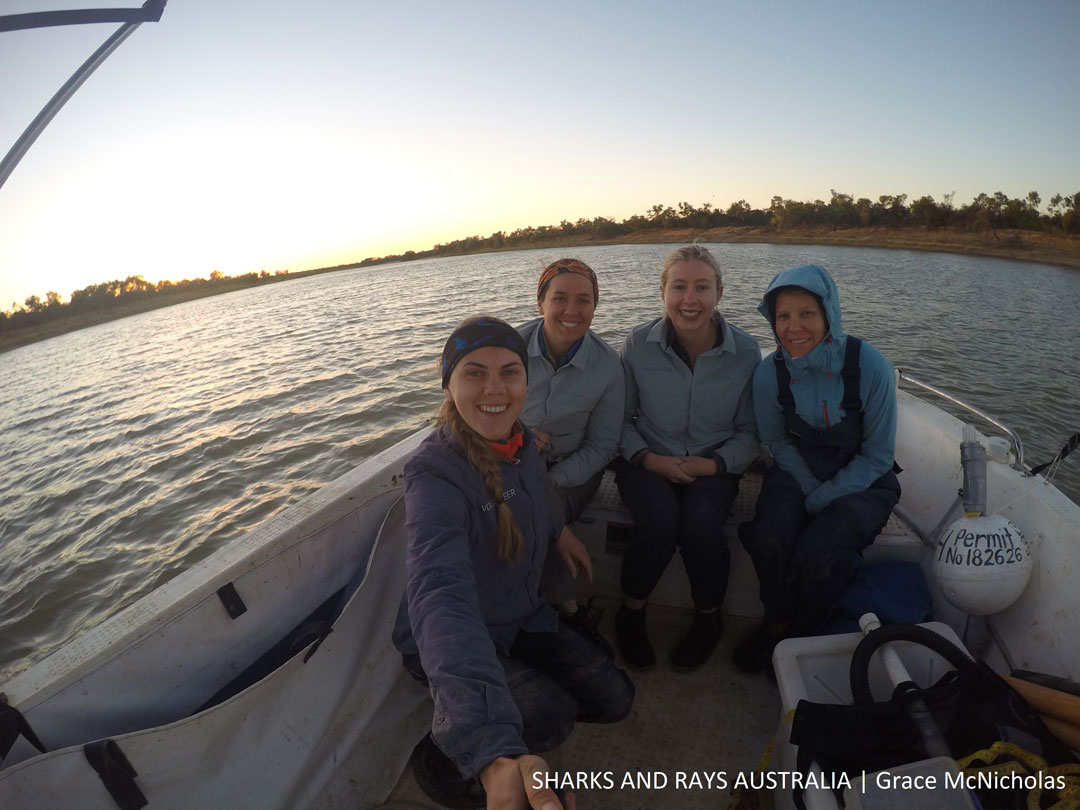
Photo by Grace McNicholas | © Sharks and Rays Australia
It was now the middle of August and I had been in Cairns since the beginning of July. As part of my master’s programme I was required to complete a two-month placement with an external organisation. I had contacted Barbara earlier that year and was lucky enough to secure a project with her, much to my excitement! After skyping a few times, and brainstorming some ideas, we decided I would investigate the effect of environmental parameters such as temperature, tide, salinity etc on sawfish distribution. I would be using data collected in the river systems of the Gulf of Carpentaria by Barbara and previous volunteers from the last four years. Of course, as grateful as I was to spend two months in sunny tropical Cairns, I couldn’t miss the opportunity to get involved with some data collection myself, so I booked myself onto the two-week Southern Gulf expedition in August and headed down under.
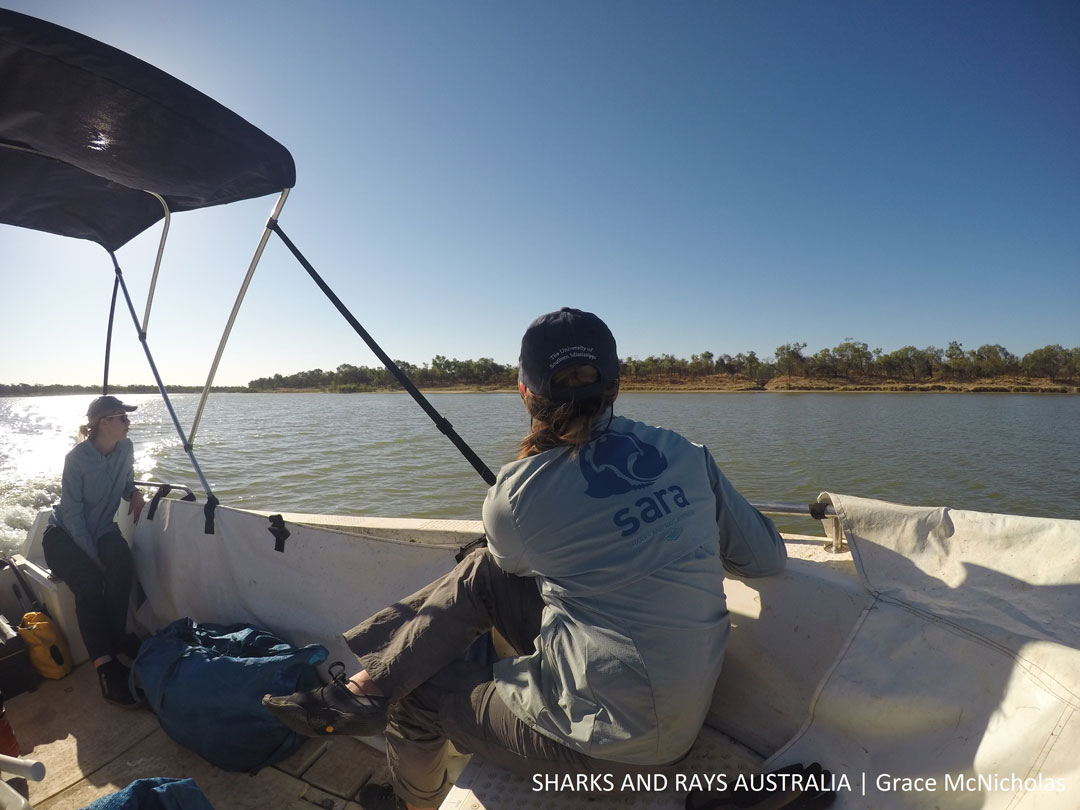
Photo by Grace McNicholas | © Sharks and Rays Australia
Barbara welcomed me with open arms and we soon began to establish a daily routine working from her home office. I would cycle to meet Barbara (on the bike she generously leant me), where I spent my days working through spreadsheets and analysing data under her guidance. When my eyes started to feel a little bit too square and I needed a break, Mr. Jaxy (Barbara’s adorable dog) was always there for a cuddle. I was loving every minute of working on this project, but I couldn’t wait to get into the field and see for myself how the data I’d been using had been collected.
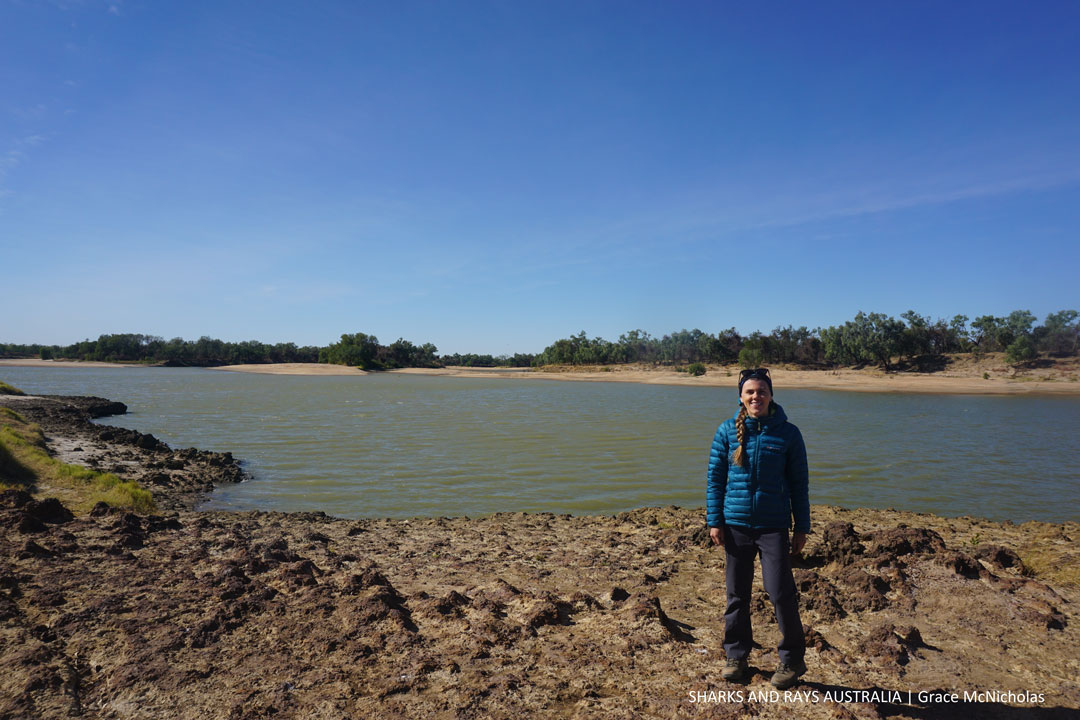
Photo by Grace McNicholas | © Sharks and Rays Australia
We met on a sunny Monday morning in Cairns and soon began packing up the Troopie and boat trailer with everything we would need to camp and conduct research for the next two weeks. Stuffed to the rafters we set of on our long drive, headed to Normanton on the west coast of Far North Queensland. After running some errands in town and stocking up on some last-minute essentials (snacks!), we made our way to the homestead of the large cattle station we had kindly been allowed to camp on. Now as an English girl, I had no concept of what a cattle station is or how big they are. So, for those of you who like me don’t know, picture an American ranch, cowboys and the lot, then add an Aussie twist. We were greeted by the managers son and daughter who gave us directions to a little dirt track which ran parallel to the river and where we would find a clearing we could set up camp. The kids joined us on a sampling session a few days later and proceeded to make fun of me for accidentally calling mustering ‘herding’ and for daring to worry about crocs and snakes (I still wasn’t quite up to speed with how the whole cattle station thing works, and ironically about the most dangerous animal in the UK is a cow).
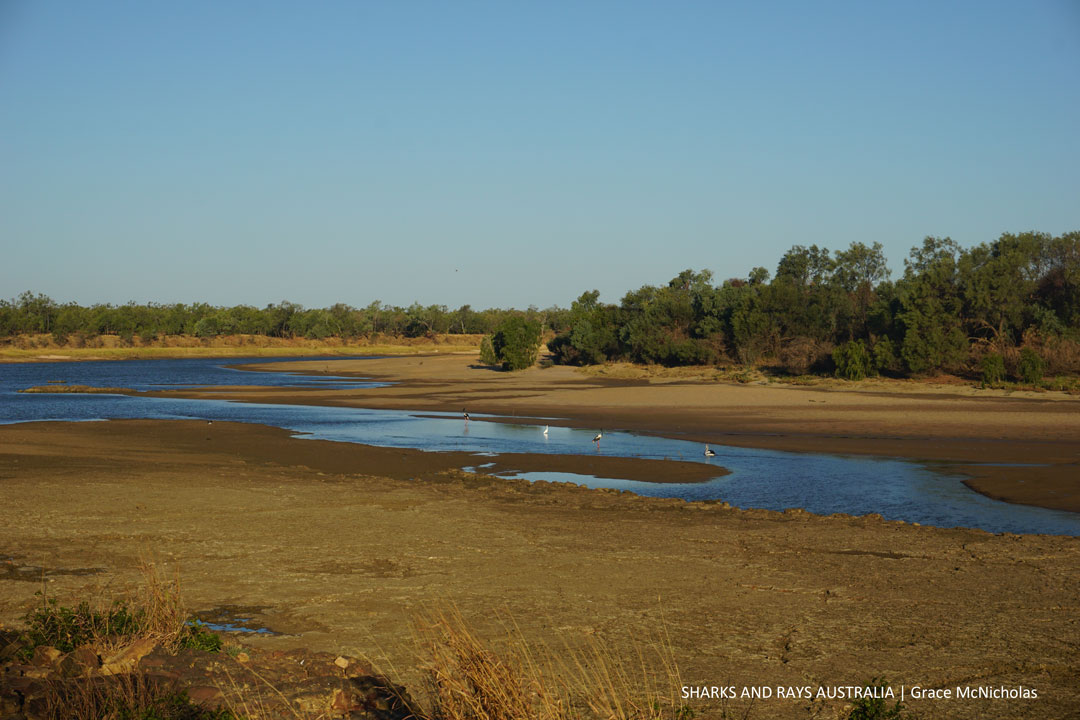
Photo by Grace McNicholas | © Sharks and Rays Australia
We found the clearing, backed the boat into the river, then after a slight mishap involving a lot of mud, furious shovelling and a tow from the cattle station manager, we were finally ready to set up camp. Being a seasoned expert, Barbara has the whole camp thing down to a fine art. We swiftly erected a large gazebo as a cooking and resting area, two privacy tents (one for our bucket water ‘showers’ and the other for our very luxurious drop toilet), and finally our own private sleeping swags. After dinner, we sat around the campfire chatting and marvelling at the night sky, the buzz of excitement growing for the days ahead.
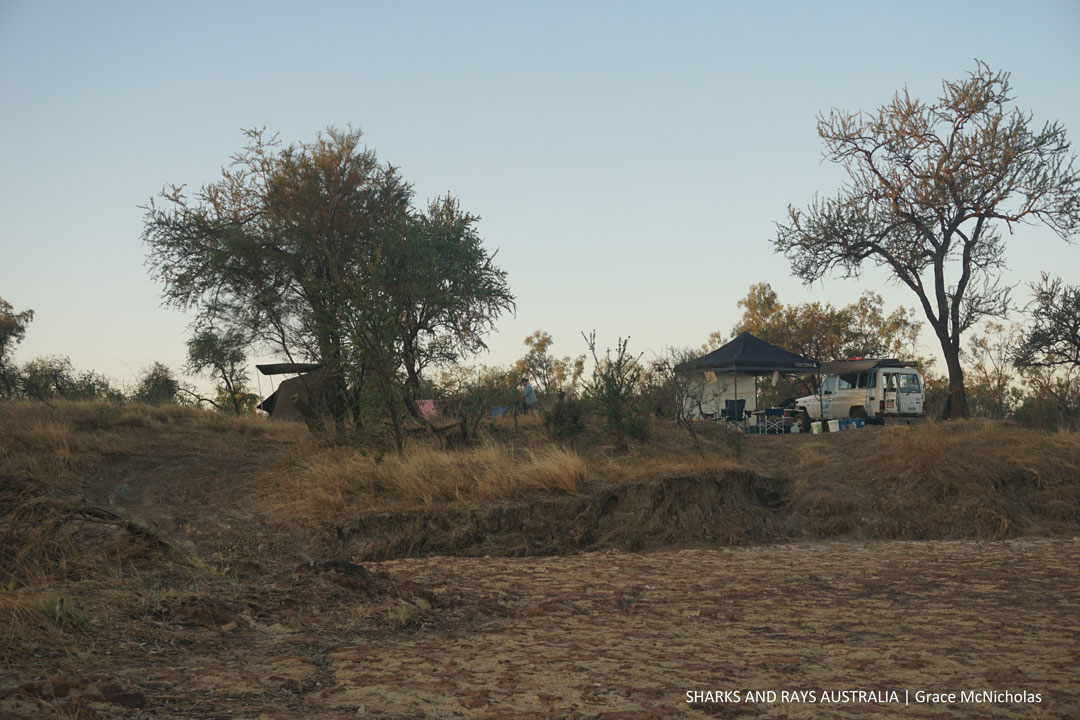
Photo by Grace McNicholas | © Sharks and Rays Australia
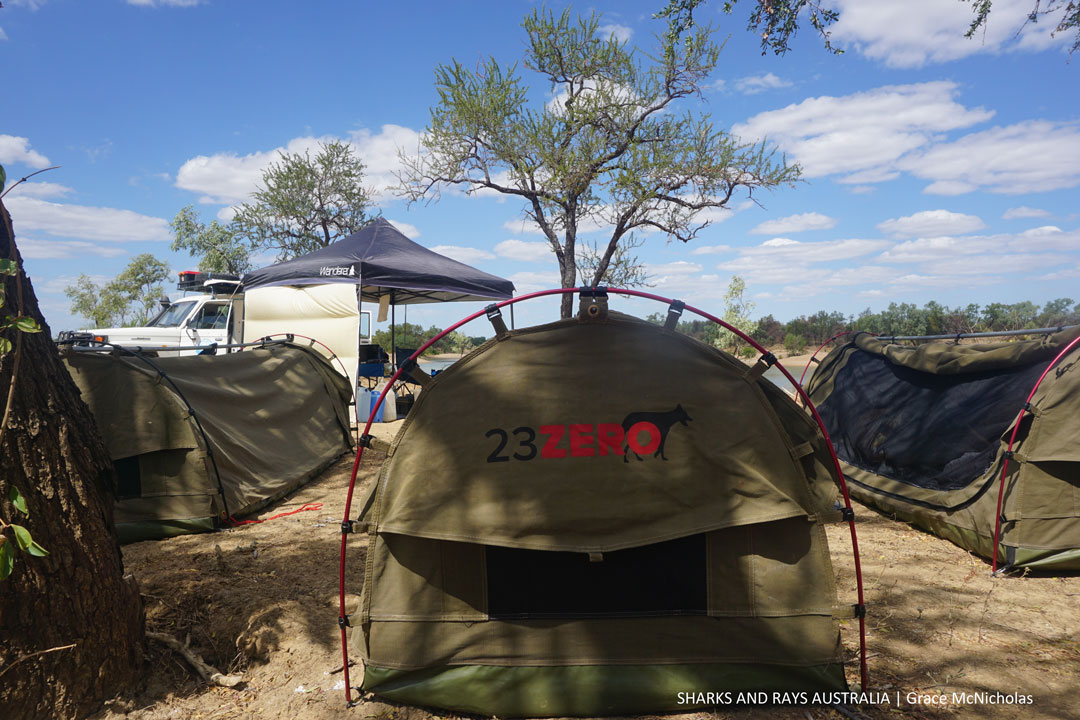
Photo by Grace McNicholas | © Sharks and Rays Australia
The next day the four of us set out on our first gillnetting session of the trip. Setting the gillnets went something like this…After finding a suitable spot, about 2 metres in depth, the first anchor, attached to one end of the net, was dropped as close to the shoreline as possible. Then while Barbara reversed the boat, the rest of the net was slowly fed out into the water. Once the net was fully taught and perpendicular to the shore, the second anchor, attached to the other end of the net, was dropped. Sounds simple right? Well thanks to Barbara’s guidance, and after a few questionable first attempts, we soon got to grips with it.
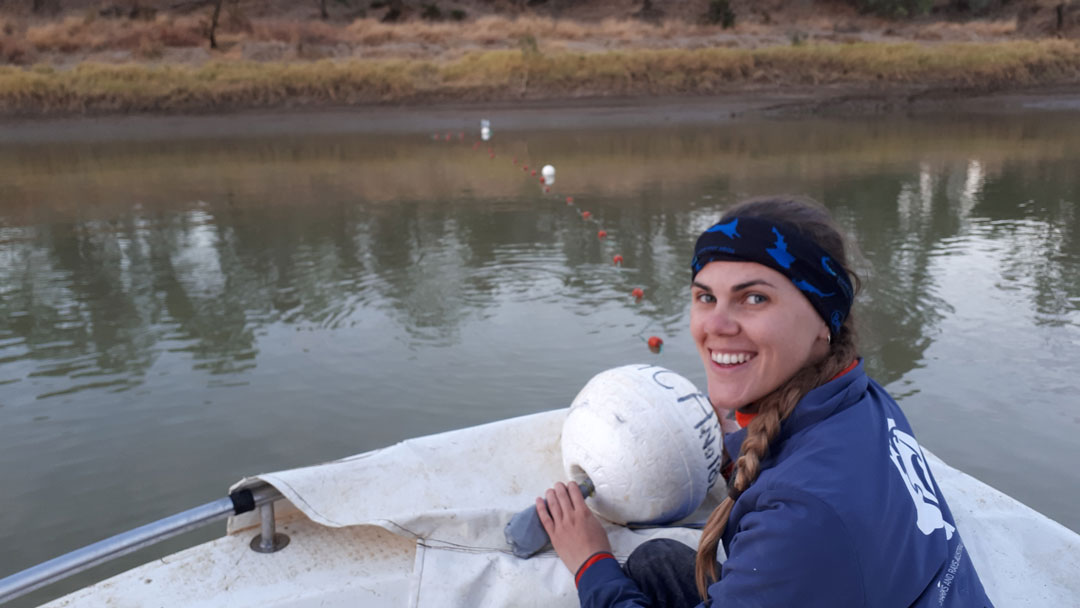
Photo © Annmarea Fearing
Sampling sessions usually consisted of setting two nets, which were always checked alternatively every 30 minutes. During the middle of checks, we would anchor the boat between the two nets and keep our fingers crossed we would catch a sawfish, ray or shark. Checking the nets requires some good spatial awareness and team work, carefully lifting the top (float line) and bottom (lead line) out of the water to check the full depth of the net for animals. It’s all hands-on deck during these sessions, untangling and measuring fish, writing down data and photographing animals to assist with later species identification. I went from having no prior gillnetting experience, to confidently setting and checking nets after just a few days, testament to being thrown in at the deep end from day one and learning on the go. Most sampling sessions were either very early in the morning, waking up at 2:30am ready to be on the water and set the nets by 3:30am, or during the cooler evenings working from late afternoon until after sunset. Animals are usually most active during these periods, so by targeting these times we’d have the most chance of catching something. We had caught a range of teleost species including bony bream, barramundi and some very cute catfish, but after three days we still had no luck finding any sawfish or other elasmobranchs. We decided to try our luck elsewhere and relocate to different river.
Apparently, the outback had different ideas.

Photo by Grace McNicholas | © Sharks and Rays Australia
We woke the next morning to strong-winds and white horses on the river, which up until now had been as flat as a pancake. We later discovered an extreme wind warning for the area had been issued, information that is not easy to come by when you are in the middle of nowhere with no signal. Getting the research vessel out without damaging it against the rocks would be impossible. On top of this the wind was pushing the surface water downstream towards the river mouth which was about 80 km away, resulting in a prolonged low tide. With no boat ramp, its essential the back wheels of the boat trailer can be reversed into the water at the correct angle so that the boat can be winched on securely. Unable to get the back wheels in deep enough due to the low tide, Barbara suggested accessing a small area on the other side of the river where a commercial fisherman had a small camp. Barbara and Julia, who had experience with 4WD, took the Troopie back down the bumpy dirt track and towards the homestead to brainstorm with the landowners. Sitting in our now half-dismantled camp (we had to take everything down to prevent it from blowing away) and snacking on gingernuts, me and Annmarie waited as the wind howled around us.
Three and a half hours later and the pair returned. It was bad news. The other area was too muddy, and there was no way to pull the boat out without getting the Troopie bogged. It was back to the drawing board. We would take it in turns to wake up every hour through the night to check the position of the tide, after marking the sand with numbered increments. My first alarm went off at 1am and after scrabbling around to find my headtorch and pulling on my walking boots, I made my way towards the water’s edge. My heart pounded as I scanned the surrounding area for two glowing red orbs, the infamous sign of crocodile eyes. Phew, no sign of crocs tonight, just the familiar glittering of spider’s eyes sprinkled across the ground. I checked the tide, which was still low, then made a note on our timetable back at camp and tucked myself into my swag until my next check at 5am. A little more confident this time, I headed straight for the shore. Surely, I would find a higher tide? No such luck, the waterline had barely moved.
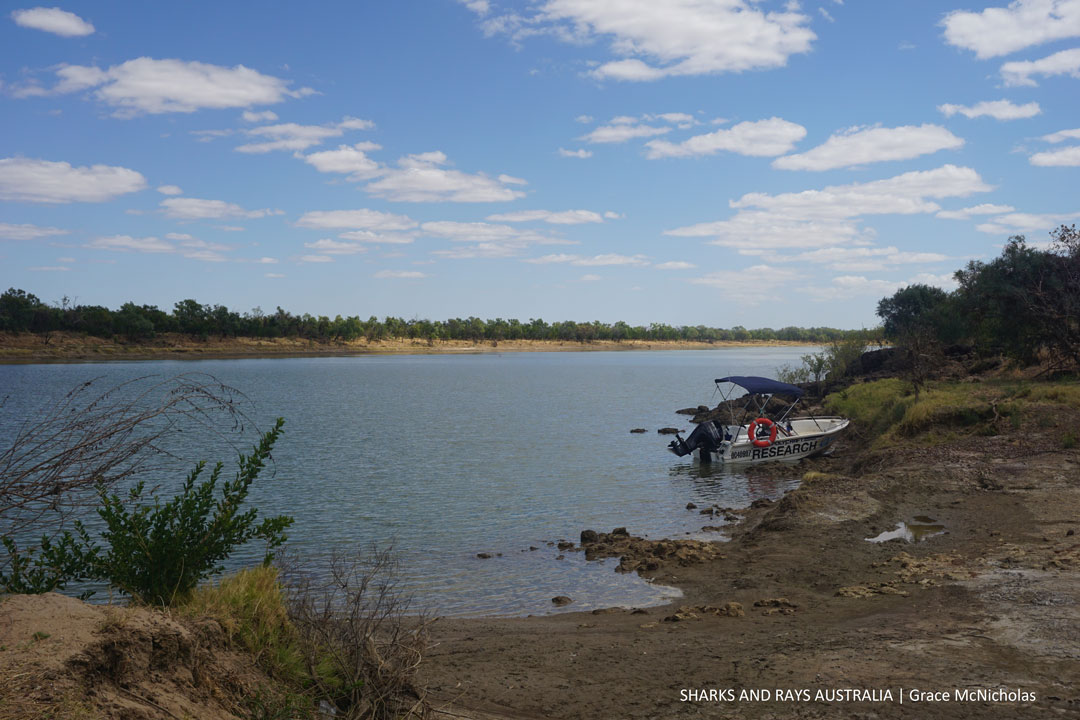
Photo by Grace McNicholas | © Sharks and Rays Australia
We discussed our next move over breakfast, which for me obviously involved a good old brew of English Breakfast Tea (I had to keep up the British Stereotype). The wind had died off and although the tide was still low, we’d have to give it our best shot to get the boat out today. After some skilful driving from Barbara, and some manual re-adjustments from all of us, we finally managed to position the trailer at the exact angle the wheels could go back far enough to get the boat on. A few painstaking hours later and the boat was on the trailer. However, the unevenness of the shoreline meant we couldn’t pull it out without tipping the boat, so back in it went.

Photo by Grace McNicholas | © Sharks and Rays Australia
Up until now the morale had been pretty high, but the midday sun and exhaustion were starting to get to us all. We agreed it was time for lunch. A can of coke and sandwich later and we were ready to try again. After driving the boat a little upstream, we accessed an area we had previously discounted as there was a large shallow sandbank blocking the boats trajectory to the shore. At first sight we still weren’t hopeful, but with some group perseverance, we managed to guide the boat onto the trailer and winch like crazy! To be honest this part was a bit of an emotional blur and the details are a little foggy. The only thing I do know for sure is I’ll never forget the comradeship and pride we all felt when the back wheels of the trailer finally made it out of the water with the boat firmly attached.
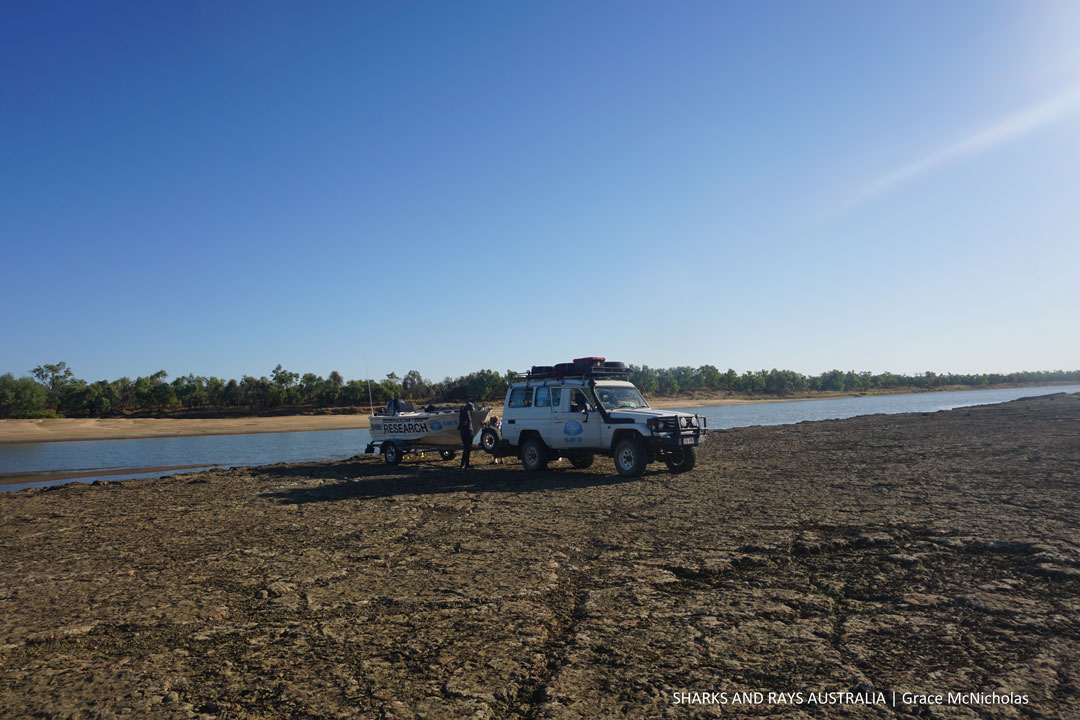
Photo by Grace McNicholas | © Sharks and Rays Australia
We spent the next night in a local campsite back in town and were all ecstatic to have running water again. We squeezed in one more sampling session in the Norman river (which to our relief there was a boat ramp), but despite keeping everything crossed we still didn’t catch any elasmobranchs. As disappointing as this was, unfortunately this is the heart-breaking reality of working with critically endangered species with severely depleted populations. The next day we had arranged to visit a local and predominately aboriginal school to talk about sawfish and the research we were doing in their local area. Outreach is an important aspect of SARA and these school visits are a fantastic opportunity to inspire the next generation of biologists and conservationists. The interaction and excitement from these kids was truly heart-warming and gives me great hope for the future.

Photo by Julia Constance | Sharks and Rays Australia
I’m back in England now, and as I sit here writing this, I can’t help but feel overwhelming proud of myself. SARA expeditions are hardcore, working in some incredibly harsh conditions, with some of the most endangered animals on the planet. From day one of landing in Cairns, to those cold river bucket showers in the outback, this experience has been the most rewarding thing I have ever done; And although I wasn’t lucky enough to see a sawfish, to have even had the opportunity to be involved in a project that could change the fate of future conservation is reward enough. Those two weeks will stay with me forever and it couldn’t be an easier decision for me to sign up for another trip next year.
I’d like to thank Julia and Annmarie for being such enthusiastic, caring team mates and Barbara, the sawfish Goddess herself, for being such a wonderful mentor and friend to all of us.
